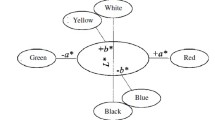Conclusions
Highly disperse pigments of various chemical structures for dyeing viscose fibres in bulk do not exert a marked effect on the change in ripeness and viscosity of the viscose with time.
Complete elimination of the formation of defect cavities and flat fibres in dyeing in bulk can be attained by reducing the ripeness index of the colored viscose.
Similar content being viewed by others
Literature cited
K. Gëttse, Manufacture of Viscose Fibre [Russian translation], A. T. Serkov, ed., Khimiya, Moscow (1972).
P. Pavlov, N. Simeonov, E. Lozanov, and K. Dimov, Godishn. Vissh. Khim.-Tekhnol. Inst. (Sofiya), 25, No. 2, 66–68 (1978 (1979)) [sic].
A. Pozler, Hemijska Vlakna, 22, No. 3–4, 9–17 (1983).
L. I. Belen'kii, D. A. Shklover, et al., in: Application of Color Science in the Textile Industry [in Russian], Legkaya Industriya, Moscow (1971), Part 1, p. 185; Part 2, p. 138.
Additional information
Translated from Khimicheskie Volokna, No. 5, pp. 34–35, September–October, 1984.
Rights and permissions
About this article
Cite this article
Kuzenkova, Z.V., Panova, L.N., Sokolova, L.P. et al. Reasons for defect formation on dyeing fibres in bulk. Fibre Chem 16, 346–348 (1985). https://doi.org/10.1007/BF00551383
Received:
Issue Date:
DOI: https://doi.org/10.1007/BF00551383



